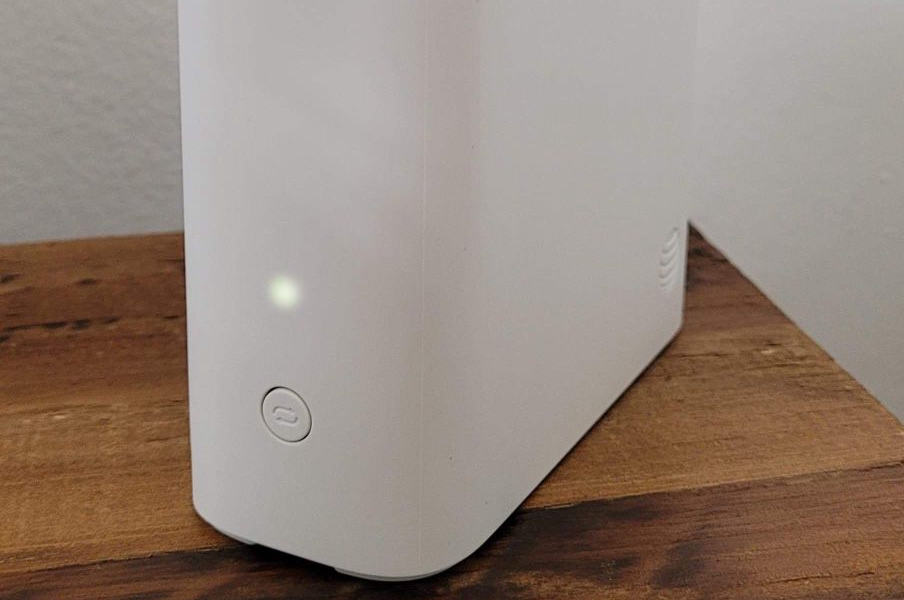A blinking green light on an AT&T extender indicates a connection attempt or a firmware update. This usually resolves itself shortly.
AT&T extenders enhance Wi-Fi coverage in your home, ensuring seamless connectivity. Occasionally, users might notice a blinking green light on their extender. This flashing light typically means the device is trying to establish a connection or undergoing a firmware update.
Patience is key, as the extender often completes these processes independently. If the light continues to blink for an extended period, checking the connection or restarting the device might help. Ensure the extender is placed within range of your primary router. This placement ensures optimal performance and eliminates potential connectivity issues. Understanding these indicators ensures your network remains efficient and reliable.
Common Causes
An AT&T Extender blinking green can be frustrating. Understanding the common causes can help you fix it. Below, we explore two main causes: power issues and network interference.
Power Issues
Power issues are a common reason for the extender blinking green. These issues can arise from multiple sources. Check the following:
- Power Cord: Ensure the power cord is securely connected.
- Power Outlet: Try plugging the extender into a different outlet.
- Power Supply: Confirm that the power supply is working correctly.
Sometimes, a simple restart can fix power issues. Unplug the extender, wait a minute, and plug it back in.
Network Interference
Network interference can also cause the extender to blink green. This interference can come from various sources. Consider the following tips:
- Wi-Fi Channels: Change the Wi-Fi channel to reduce interference.
- Physical Obstructions: Move the extender to a more open area.
- Other Devices: Keep the extender away from other electronic devices.
Use a Wi-Fi analyzer to identify the best channels. This can help reduce network interference.
Initial Checks
Experiencing an ATT Extender blinking green? Before jumping to complex fixes, conduct some initial checks. These basic steps can resolve many common issues. Follow the guide below to get started.
Power Cycle
A power cycle can often solve connectivity problems. Follow these simple steps:
- Unplug the extender from the power outlet.
- Wait for 30 seconds.
- Plug it back into the power outlet.
Once powered back, check if the green light stops blinking. If it continues, proceed to the next step.
Cable Connections
Improper cable connections can cause the ATT Extender to blink green. Ensure all cables are securely connected:
- Check the Ethernet cable from the extender to the router.
- Inspect the power cable connection.
- Ensure no cables are loose or damaged.
Secure connections can resolve many issues. Verify all cables are in good condition.
These initial checks are quick and easy. They help diagnose common problems with your ATT Extender.
Router Compatibility
Understanding router compatibility is crucial when dealing with an Att Extender blinking green. Ensuring your router is compatible can resolve connectivity issues. Dive into the following sections to learn more.
Regular firmware updates are essential for maintaining router performance. Check your router manufacturer’s website for updates. Ensure your router’s firmware is the latest version.
Follow these steps to update firmware:
- Log in to your router’s admin panel.
- Navigate to the Firmware Update section.
- Download and install the latest firmware.
Updating firmware can improve compatibility with the Att Extender.
Router Settings
Adjusting your router settings can help resolve the blinking green issue. Ensure your router’s settings are optimized for the extender. Here are some settings to check:
| Setting | Recommended Value |
|---|---|
| Channel | Auto |
| Frequency | 2.4 GHz and 5 GHz |
| Security | WPA2 |
Make sure your router broadcasts both 2.4 GHz and 5 GHz frequencies. This ensures better compatibility with the Att Extender.
Always use WPA2 security for better protection and performance.
Credit: www.att.com
Signal Strength
Understanding the signal strength of your AT&T Extender is crucial. It helps in ensuring a stable and fast internet connection. A blinking green light on your extender usually indicates a good signal strength. But, to maintain this, you need to consider several factors such as optimal placement and avoiding obstacles.
Optimal Placement
Place your AT&T Extender in a central location. This helps cover all areas evenly. Keep it away from walls and corners. These can block the signal. Use a shelf or a table at waist height. This is often the best spot.
- Keep it away from windows.
- Avoid placing it in the basement.
- Ensure it is at least 3 feet off the ground.
Avoiding Obstacles
Obstacles can weaken the signal strength. Keep the extender away from large metal objects. These include refrigerators and metal shelves. Avoid placing it near electronic devices like microwaves and cordless phones.
| Obstacle | Impact on Signal |
|---|---|
| Walls | Moderate to High |
| Metal Objects | High |
| Electronic Devices | Moderate |
Here is a quick checklist to avoid obstacles:
- Move away from large metal objects.
- Keep distance from electronic devices.
- Avoid placing near thick walls.
By following these tips, you ensure a strong and stable signal. This will help keep your AT&T Extender blinking green.
Device Configuration
Configuring your ATT Extender properly ensures optimum performance and connectivity.
A green blinking light often indicates configuration issues. Below are the steps to reset and reconfigure your device.
Factory Reset
Sometimes, a factory reset is necessary to resolve persistent issues. Follow these steps to reset your ATT Extender:
- Locate the Reset Button on your ATT Extender.
- Press and hold the button for 10 seconds.
- Release the button when the lights turn off and on again.
- Wait for the device to reboot completely.
Your device should now be restored to its factory settings.
Reconfiguration Steps
After a factory reset, you need to reconfigure your device. Here are the steps:
- Connect your computer to the ATT Extender using an Ethernet cable.
- Open a web browser and enter the IP address
192.168.1.1. - Log in using the default username and password.
- Navigate to the Setup tab and select Wireless Settings.
- Configure your SSID and Password as desired.
- Click Save to apply the new settings.
Your ATT Extender should now be fully configured and ready to use.
Firmware Updates
Firmware updates are crucial for maintaining the performance of your ATT Extender. Blinking green lights often indicate that an update is necessary. This section will guide you through checking for updates and the updating process.
Checking For Updates
To ensure your ATT Extender is running the latest firmware, follow these steps:
- Open your web browser.
- Type the extender’s IP address in the address bar.
- Log in using your admin credentials.
- Navigate to the Firmware or Update section.
- Check for available updates.
Updating Process
Once you’ve checked for updates, follow these instructions to update your firmware:
- Download the latest firmware file if available.
- Go to the Firmware Update section on the extender’s interface.
- Click on the Upload button.
- Select the downloaded firmware file.
- Click Start to begin the update.
- Wait for the process to complete. Do not turn off the extender.
- Once done, the extender will reboot automatically.
Ensure your extender is connected to a stable power source. Interruptions can cause issues during the update.
Advanced Settings
Advanced settings can enhance the performance of your AT&T extender. By fine-tuning these settings, you can resolve issues like the blinking green light. This guide covers the essential advanced settings for optimal performance.
Channel Selection
Choosing the right channel is crucial. Channels can affect the extender’s speed and range. Follow these steps:
- Log in to your extender’s web interface.
- Navigate to the Wireless Settings tab.
- Select a channel with less interference. Channels 1, 6, and 11 are ideal.
Use a Wi-Fi analyzer to identify the best channel. This tool can detect crowded channels. Switching to a less crowded channel can reduce interference.
Bandwidth Management
Bandwidth management helps to allocate resources efficiently. It ensures that your network performs well. To manage bandwidth:
- Access the extender’s web interface.
- Go to the Quality of Service (QoS) settings.
- Prioritize devices and applications. Essential devices should get more bandwidth.
Set limits for non-essential devices. This ensures that critical devices get the required bandwidth. You can also schedule bandwidth usage. This helps in avoiding congestion during peak hours.
| Setting | Description | Recommendation |
|---|---|---|
| Channel | Frequency band used for communication | Use channels 1, 6, or 11 |
| Bandwidth Limit | Maximum data rate for devices | Prioritize critical devices |
| QoS | Quality of Service | Enable for better performance |
By adjusting these advanced settings, you can improve your extender’s performance. This can stop the blinking green light issue.
Support Options
Experiencing the ATT Extender Blinking Green issue can be frustrating. Fortunately, several support options are available to help you resolve the problem. You can either contact your ISP or seek professional help. Let’s explore these options in detail.
Contacting Isp
Your Internet Service Provider (ISP) is the first place to seek help. They have access to your network details and can provide specific guidance. Follow these steps to contact your ISP:
- Locate the customer support number on your bill or their website.
- Call the number and follow the prompts to reach technical support.
- Explain that your ATT Extender is blinking green and request assistance.
Your ISP may ask you to perform some basic troubleshooting steps. They might also check for any outages or issues on their end. If the problem persists, they may send a technician to your home.
Professional Help
If contacting your ISP does not resolve the issue, consider seeking professional help. Many local technicians specialize in network issues and can offer in-home support. Here are some ways to find professional help:
- Search online for local network technicians or IT support services.
- Read reviews and compare prices before making a choice.
- Call and explain that your ATT Extender is blinking green.
A professional will visit your home and diagnose the problem. They have advanced tools and expertise to fix complex issues quickly. This option might cost more but ensures a swift resolution.

Credit: www.homeowner.com
Frequently Asked Questions
Why Is My Wifi Extender Blinking Green?
A blinking green light on your WiFi extender indicates a stable connection with your router. It shows optimal performance.
What Color Should Light Be On An At&t Extender?
The light on an AT&T extender should be solid green. This indicates a strong connection and proper functioning.
How Do I Know If My At&t Extender Is Working?
Check the LED lights on your AT&T extender. Green lights indicate it’s working. Also, verify improved Wi-Fi signal strength.
How To Reconnect At&t Wifi Extender?
To reconnect your AT&T WiFi extender, unplug it, wait 10 seconds, and plug it back in. Ensure it’s within range of your router. Use the AT&T Smart Home Manager app to complete the setup.
Why Is My Att Extender Blinking Green?
A blinking green light indicates the extender is trying to establish a connection.
Conclusion
Understanding why your AT&T extender is blinking green is essential. This guide helps you troubleshoot and resolve issues. Follow the steps to ensure a stable connection. A reliable extender boosts your internet experience. Stay connected without interruptions and enjoy seamless browsing.

